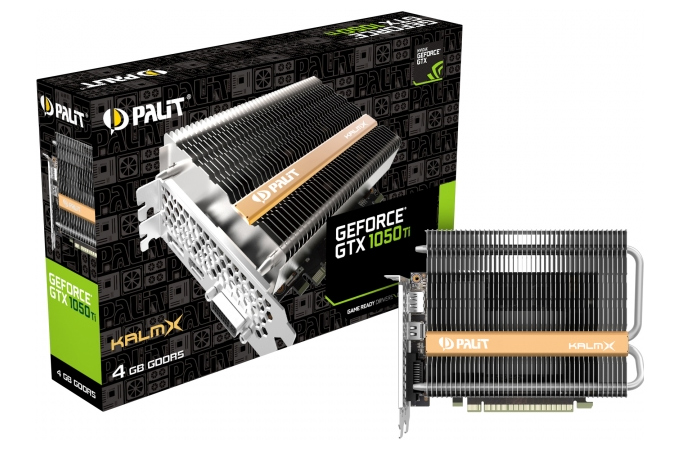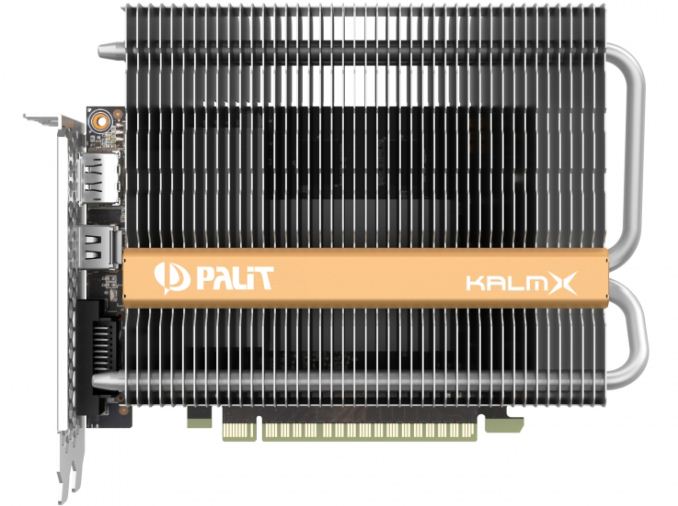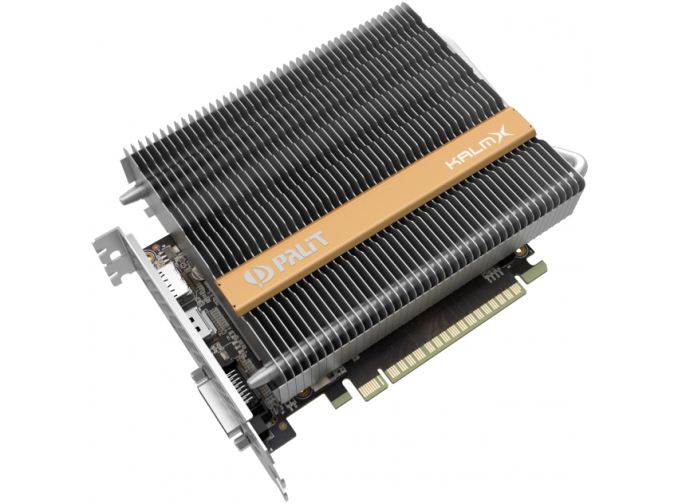Palit Announces KalmX: A Passively-Cooled GeForce GTX 1050 Ti Graphics Card
by Anton Shilov on February 7, 2017 6:00 PM EST
Palit has quietly launched a passively-cooled graphics card based on NVIDIA’s GeForce GTX 1050 Ti GPU. The sizeable board uses a large aluminum heatsink with heat pipes and requires substantial height clearance in a case. Meanwhile, its indisputable trump card is a lack of any noise.
Producers of graphics cards nowadays tend to differentiate from each other by using different cooling systems and increasing performance of their products by boosting GPU frequencies beyond the recommendations of GPU developers. Modern high-end graphics cards use coolers with two or even three fans with a low rotation speed to reduce noise levels, but it is hard to find a passively-cooled graphics board that produces no noise at all. Palit decided to go head first into this and developed a video card with a passive cooler featuring a contemporary GPU powered by NVIDIA’s Pascal architecture under the brand KalmX.
The Palit GeForce GTX 1050 Ti KalmX uses a unique PCB design and has a dual-slot aluminum heatsink that features two heat pipes. The card runs at reference frequencies (1290/1392 MHz base/boost for the GP107 GPU) and is equipped with 4 GB of GDDR5 memory operating at 7000 MT/s. The board does not require any additional power connectors as it consumes no more than 75 W, but its cooler is large and may not fit into some compact computers. As for connectivity, the board features an HDMI 2.0b output, a DisplayPort 1.4 as well as a dual-link DVI-D header.
Palit did not announce MSRP of the GeForce GTX 1050 Ti KalmX and it is unclear whether the producer plans to charge a premium versus NVIDIA’s MSPR for the GTX 1050 Ti ($139) for passive cooling. At press time, one of Amazon’s partners was selling Palit’s passively-cooled GeForce GTX 750 Ti KalmxX Silent 2 GB for $238, but such overprice is not common. If we get updated pricing, we'll update this news.
Related Reading:
Source: Palit


















24 Comments
View All Comments
phoenix_rizzen - Tuesday, February 7, 2017 - link
Oooohhh, we're getting close to having a replacement to the ancient GT 730. All they need to do now is make it half-height (full-length is fine). :)SaolDan - Tuesday, February 7, 2017 - link
Maybe the 940SaolDan - Tuesday, February 7, 2017 - link
I mean 1040DanNeely - Wednesday, February 8, 2017 - link
it'd also need to be about half the current TDP. Either the long rumored but still MIA GP108, or the massively cut down to 33/50% of full size GP107 parts used in the recently announced bottom tier Quadro cards.BrokenCrayons - Wednesday, February 8, 2017 - link
It certainly looks like NV is done releasing Pascal-based graphics cards. Given that they've finished out the Quadro line with cut down GP107 chips, I don't expect we'll see anything built with lower end specs along the lines of a hypothetical GP108. The niche a lot of us seeking lower TDP cards reside in is probably too small to serve. We may have to make do with iGPUs or break open our piggy banks to spring for a low end Quadro.DanNeely - Wednesday, February 8, 2017 - link
The 25-40W market segment's important for mobile though; and since NVidia used butchered K107 chips instead of intact K108's for their previous generation tiny Quadro lineup the current situation's less strongly indicative than I'd assumed yesterday. Especially since the heavily cut down GK107 Quadro cards ran much hotter than the similar performing GK108 Geforces.jwufohunter - Thursday, February 9, 2017 - link
They have that already. MSI and Galax makes them.alexdi - Tuesday, February 7, 2017 - link
I think the time for cards like this has passed. Many modern GPUs turn the fans off entirely at low loads. If it gets to the point where you can hear the fans, that's not a load a passive heatsink could handle anyway.jospoortvliet - Wednesday, February 8, 2017 - link
For me it is useful due to my case. I have the Silverstone ft03 mini. It would either need a blower (super noisy!) or this. Normal fans would risk to keep too much hot air in the case.The downside of this card is that the fins are not parallel to the flow of air in the case decreasing the efficiency of the cooling. But it will probably still suffice...
MrSpadge - Wednesday, February 8, 2017 - link
If an open air cooler keeps too much heat inside the chassis, how is this passive cooler any better? It keeps the heat exactly where it was generated and waits for slow convection. If your case cooling is strong enough to deal with that, the heat output from an open air cooler would similarly be blown away.